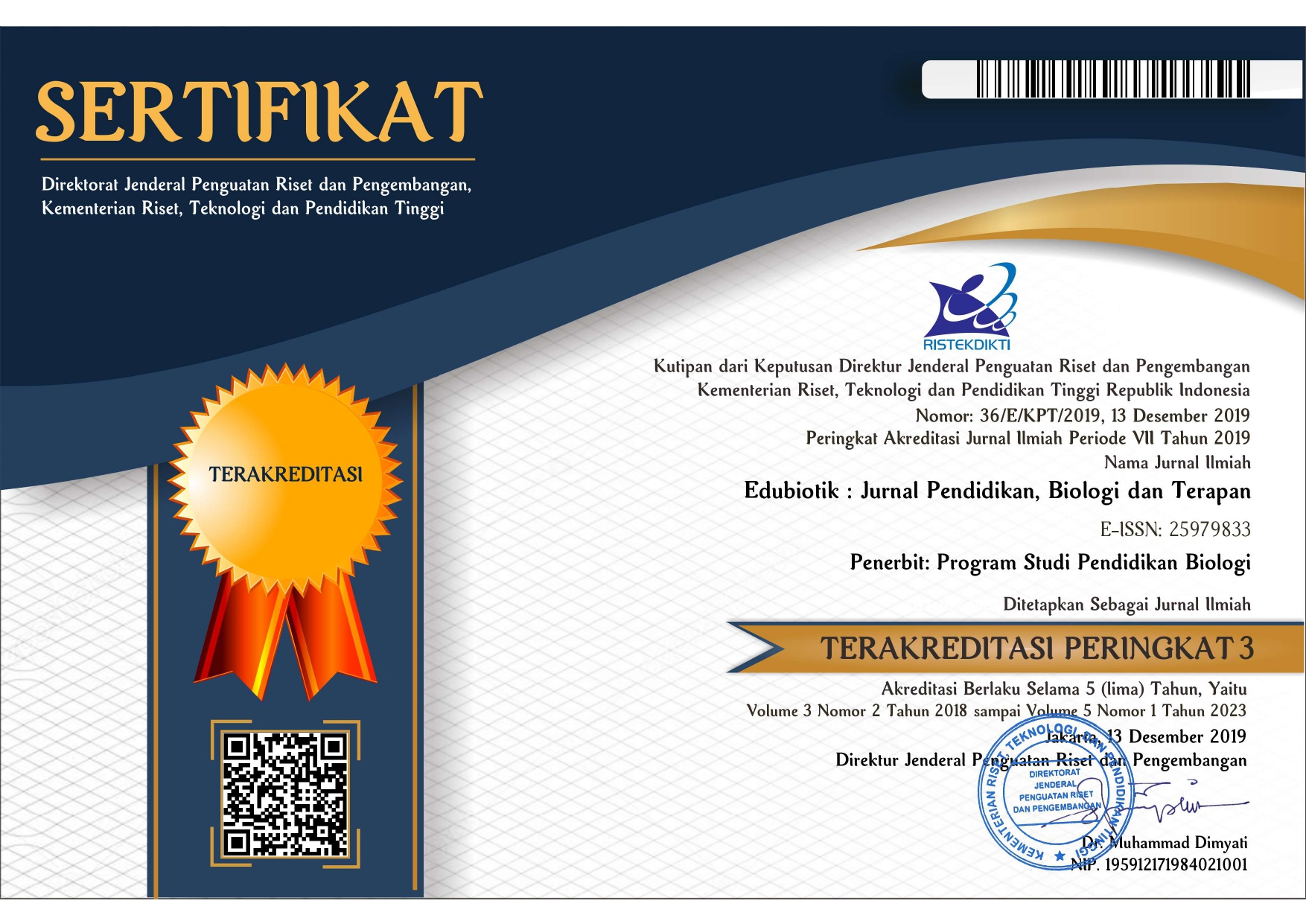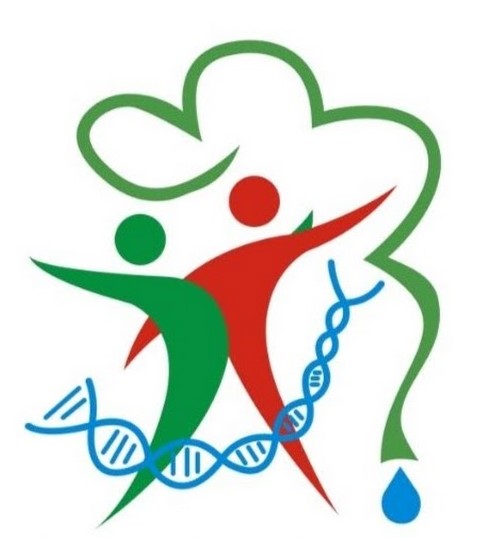Red onion (Allium ascalonicum L.) skin as an antibacterial on the growth of Staphylococcus aureus
Abstract
The main bacteria that cause infection in humans is Staphylococcus aureus. Efforts to prevent infectious diseases caused by bacteria can be made by using plant parts that have medicinal potential. One part of the plant that needs to be explored for its potential is the skin of shallot bulbs (Allium ascalonicum L.). This research aimed to determine the effect of red onion skin extract on the growth of S. aureus bacteria. The research design is experimental. The samples in this study were 1 kg of red onion skin and a bacterial sub-culture of S. aureus ATCC: 25923. Extraction was carried out using the maceration method using 96% ethanol solvent and evaporated using a rotary evaporator and water bath. The antibacterial test was carried out by administering 30 µg chloramphenicol (positive control), sterile distilled water (negative control), and red onion skin extract with concentrations of 60%, 65%, 70%, and 75% with 3 repetitions. All treatments were given to S. aureus at 30 µL each using the Kirby-Baeur method. The research instrument was an observation sheet of the diameter of the inhibition zone. Data analysis used One-Way ANOVA. The results of this study show that ethanol extract of red onion skin with concentrations of 60%, 65%, 70%, and 75% was able to produce S. aureus inhibition zone diameters of 3.5 mm, 4 mm, 4.2 mm, and 4.3 mm. The results of the One-Way ANOVA test showed a significance value of 0.15 (sig>0.05), not proven to be able to significantly inhibit the growth of S. aureus. The conclusion shows that red onion skin extract as an antibacterial is not able to significantly inhibit the growth of S. aureus.
References
Ali-Alghamdi, B., Al-Johani, I., Al-Shamrani, J. M., Musamed Alshamrani, H., Al-Otaibi, B. G., Almazmomi, K., & Yusnoraini Yusof, N. (2023). Antimicrobial resistance in methicillin-resistant Staphylococcus aureus. Saudi Journal of Biological Sciences, 30(4), 103604. https://doi.org/10.1016/j.sjbs.2023.103604
Anh, P. T. H., Truc, L. T. G., & An, T. T. T. (2023). Shallot peel (Allium ascalonicum L.) extract, the antioxidative, antibacterial properties and fish preservation capacity. Vietnam Journal of Chemistry, 61(2), 253–261. https://onlinelibrary.wiley.com/doi/full/10.1002/vjch.202200147
Badriyah, L., & Farihah, D. A. (2022). Analisis ekstraksi kulit bawang merah (Allium cepa L.) menggunakan metode maserasi. Jurnal Sintesis: Penelitian Sains, Terapan dan Analisisnya, 3(1), 30–37. https://doi.org/10.56399/jst.v3i1.32
Clinical Laboratory and Standard Institute. (2020). CLSI M100-ED29: Performance standards for antimicrobial susceptibility testing, 30th Edition. https://www.clsi.org/
Elsyana, V., & Tutik. (2018). Penapisan fitokimia dan skrining toksisitas ekstrak etanol kulit bawang merah. JURNAL FARMASI MALAHAYATI, 1(2), 107–114. https://ejurnalmalahayati.ac.id/index.php/farmasi/article/view/1243
Elsyana, V., Hidayat, M. A., & Tutik. (2019). Uji toksisitas dan skrining ekstrak kulit bawang merah (Allium cepa L). JURNAL FARMASI MALAHAYATI, 2(1), 41–49. https://ejurnalmalahayati.ac.id/index.php/farmasi/article/view/1543
Ezeh, C. K., Eze, C. N., Dibua, M. E. U., & Emencheta, S. C. (2023). A Meta-analysis on the prevalence of resistance of Staphylococcus aureus to different antibiotics in Nigeria. Antimicrobial Resistance and Infection Control, 12(1), 1–22. https://doi.org/10.1186/s13756-023-01243-x
Fauziah, D. T., & Isnawati, N. (2023). Antibacterial activities of shallot (Allium cepa) and garlic (Allium sativum) skin extracts. International Journal of Pharmaceutical and Bio-Medical Science, 03(06). https://doi.org/10.47191/ijpbms/v3-i6-09
Ikuta, K. S., Swetschinski, L. R., Aguilar, G. R., Sharara, F., Mestrovic, T., Gray, A. P., Weaver, N. D., Wool, E. E., Han, C., Hayoon, A. G., Aali, A., Abate, S. M., Abbasi-Kangevari, M., Abbasi-Kangevari, Z., Abd-Elsalam, S., Abebe, G., Abedi, A., Abhari, A. P., Abidi, H., … Naghavi, M. (2022). Global mortality associated with 33 bacterial pathogens in 2019: A systematic analysis for the Global Burden of Disease Study 2019. The Lancet, 400(10369), 2221–2248. https://doi.org/10.1016/S0140-6736(22)02185-7
Jamilah. (2015). Evaluasi keberadaan gen catp terhadap resistensi kloramfenikol pada penderita demam tifoid. Prosiding Seminar Nasional Mikrobiologi Kesehatan dan Lingkungan Makassar 29 Januari 2015, 146–152. https://media.neliti.com/
Kabrah, A. M., Faidah, H. S., Ashshi, A. M., & Turkistani, S. A. (2016). Antibacterial effect of onion. Scholars Journal of Applied Medical Sciences, 4(11), 4128–4133. https://www.saspublishers.com/article/12125/
Khashan, A. A. (2014). Antibacterial activity of garlic extract (Allium sativum ) against Staphylococcus aureus in vitro. Global Journal of Bio-Sciencie and Biotechnology, 3(4), 346–348. http://www.scienceandnature.org/GJBB_Vol3(4)2014.php
Khusnia, K. (2020). Aktivitas antibakteri fraksi etanol dan n-heksan umbi bawang merah (Allium cepa L.) Terhadap Bakteri Staphylococcus aureus penyebab bisul. In Skripsi. http://repository.stikes-bhm.ac.id/1175/
Misna, & Diana, K. (2016). Aktivitas antibakteri ekstrak kulit bawang merah (Allium cepa L.) terhadap bakteri Staphylococcus aureus. Jurnal Farmasi Galenika (Galenika Journal of Pharmacy), 2(2), 138–144. https://doi.org/10.22487/j24428744.2016.v2.i2.5990
Mulyani, S. Purwanto, Sudarsono, Wahyono, Pramono, S., Purwantini, I., Puspitasari, A., Santoso, D., Hertiani, T., Fakhrudin, N., Murti,Y.B., & Utami, S. (2020). Minyak Atsiri: Tumbuhan Obat. Gadjah Mada University Press: Yogyakarta
Murray, C. J. L., Ikuta, K. S., Sharara, F., Swetschinski, L., Aguilar, G. R., Gray, A., Han, C., Bisignano, C., Rao, P., Wool, E., Johnson, S. C., Browne, A. J., Chipeta, M. G., Fell, F., Hackett, S., Haines-Woodhouse, G., Hamadani, B. H. K., Kumaran, E. A. P., McManigal, B., … Naghavi, M. (2022). Global burden of bacterial antimicrobial resistance in 2019: A systematic analysis. The Lancet, 399(10325), 629–655. https://doi.org/10.1016/S0140-6736(21)02724-0
Nandasari, A. D. (2020). Skrining fitokimia dan identifikasi senyawa aktif ekstrak air, etanol, dan n-hekasana kulit bawang merah (Alium cepa L.) hasil hidrolisis dengan metode kromatografi lapis tipis analitik (KLT-A). In Skripsi. http://etheses.uin-malang.ac.id/24213/
Nassar, M. S. M., Hazzah, W. A., & Bakr, W. M. K. (2019). Evaluation of antibiotic susceptibility test results: How guilty a laboratory could be?. Journal of the Egyptian Public Health Association, 94(1), 1–5. https://doi.org/10.1186/s42506-018-0006-1
Negara, K. S. (2014). Analisis implementasi kebijakan penggunaan antibiotika rasional untuk mencegah resistensi antibiotika di RSUP Sanglah Denpasar: Studi kasus infeksi methicillin resistant Staphylococcus Aureus. Jurnal ARSI, 1(1), 42–50. http://dx.doi.org/10.7454/arsi.v1i1.2169
Octaviani, M., Fadhli, H., & Yuneistya, E. (2019). Uji aktivitas antimikroba ekstrak etanol kulit bawang merah (Allium cepa L.) dengan metode difusi cakram. Pharmaceutical Sciences and Research, 6(1), 62–68. https://doi.org/10.7454/psr.v6i1.4333
Prabowo, A., & Noer, S. (2020). Uji kualitatif fitokimia kulit bawang merah (Allium ascalonicum). Prosiding Semnas Sains, 1(1), 250–253. https://proceeding.unindra.ac.id/index.php/sinasis/article/view/4074
Pranata, A., Tutik, & Marcellia, S. (2021). Perbandingan efektivitas ekstrak etil asetat dan n-heksana kulit bawang merah (Allium cepa L.) sebagai larvasida Aedes aegypti. Ilmu Kedokteran Dan Kesehatan, 8(4), 325–333. https://doi.org/10.33024/jikk.v8i4.5140
Pudiarifanti, N., & Farizal, J. (2022). Skrining fitokimia dan aktivitas antibakteri ekstrak bawang putih tunggal terhadap Staphylococcus aureus. Jurnal Farmasi Higea, 14(1), 66–71. http://dx.doi.org/10.52689/higea.v14i1.450
Rosyada, A. G. (2022). Skrining fitokimia dan uji aktivitas ekstrak etanol kulit bawang merah (Allium cepa L.) dalam menghambat pembentukan biofilm Staphylococcus aureus. in Skripsi. http://repository.unsoed.ac.id/17857/
Roza, D., Kornialia, & Edrizal. (2017). Uji aktivitas antibakteri ekstrak etanol bawang merah (Allium cepa L.) terhadap zona hambat pertumbuhan Streptococcus viridians. B-Dent: Jurnal Kedokteran Gigi Universitas Baiturrahmah, 4(2), 83–95. https://doi.org/10.33854/JBDjbd.99
Rungelrath, V., & DeLeo, F. R. (2021). Staphylococcus aureus, antibiotic resistance, and the interaction with human neutrophils. Antioxidants and Redox Signaling, 34(6), 452–470. https://doi.org/10.1089/ars.2020.8127
Sa`adah, H., Supomo, & Musaenah. (2020). Aktivitas antibakteri ekstrak air kulit bawang merah (Allium cepa L.) terhadap bakteri Propionibacterium acnes. Jurnal Riset Kefarmasian Indonesia, 2(2), 80–88. https://doi.org/10.33759/jrki.v2i2.73
Setiani, A. L., Sari, L. B., Indriani, L., & Jupersio. (2017). Penentuan kadar flavonoid ekstrak etanol 70% kulitbawang merah (Allium cepa L.) dengan metode maserasi dan MAE (Microwave Assisted Extraction). Jurnal Fitofarmaka, 7(2), 1–14. https://doi.org/10.33751/jf.v7i2.772
Setiawati, A. (2015). Peningkatan resistensi kultur bakteri Staphylococcus aureus terhadap amoxicillin menggunakan metode adaptif gradual. Jurnal Farmasi Indonesia, 7(3), 190–194. https://www.researchgate.net/
Suryandari, M., & Kusumo, G. G. (2022). Identifikasi senyawa metabolit sekunder ekstrak kulit bawang merah (Allium cepa L.) dari berbagai macam pelarut. Journal Pharmasci (Journal of Pharmacy and Science), 7(2), 131–135. http://repository.akfarsurabaya.ac.id/765/
Tyasningsih, W., Ramandinianto, S. C., Ansharieta, R., Witaningrum, A. M., Permatasari, D. A., Wardhana, D. K., Effendi, M. H., & Ugbo, E. N. (2022). Prevalence and antibiotic resistance of Staphylococcus aureus and Escherichia coli isolated from raw milk in East Java, Indonesia. Veterinary World, 15(8), 2021–2028. https://doi.org/10.14202/vetworld.2022.2021-2028
Wulaisfan, R., Musdalipah, & Nurhadiah. (2018). Aktivitas ekstrak kulit bawang merah (Allium ascalonicum L.) terhadap pertumbuhan bakteri streptococcus mutans penyebab karies gigi. Jurnal Ilmiah Farmasi, 1(2), 126–132. https://ejournal.unisba.ac.id/index.php/Farmasyifa/article/view/3769





.png)
2.png)

1.jpg)


